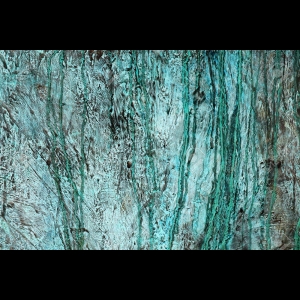♦Livre♦
Experiments in Egyptian Archaeology: Stoneworking Technology in Ancient Egypt
108. At Giza, Petrie26 noticed green staining on the sides of some Fourth Dynasty saw-cuts in stone, which he ascribed to bronze, but was more likely to have been copper in the Fourth Dynasty. Grains of sand, also stained green, were found in a saw-cut at Giza by Petrie.27 In a piece of basalt, from the pavement on the eastern side of the Great Pyramid, Petrie noticed a saw-cut with the sawing dust and sand still left in it.28 Tubular drill marks exist on a block of stone from the Fifth Dynasty complex of Nyuserre, which bears traces of verdigris left from the use of a copper drill-tube.29
108. Alfred Lucas examined a hole made by a tubular drill in a fragment of alabaster (CM JE65402), of Third Dynasty date, from the Step Pyramid at Saqqara. In the hole, there was a compact mass of what was almost certainly the abrasive powder of a light green colour. The powder consisted of naturally rounded, very fine grains of quartz sand and the colour was due to a copper compound, evidently from the drill used.30
108. Also at Saqqara, Lucas examined a large drill core about 8 cm in diameter, of coarse-grained red granite with green patches on the outside from the copper of the drill.31 G.A. Reisner32 found fine gritty powder, tinged green, in holes made by a tubular drill in two unfinished Fourth Dynasty stone artifacts. In a hole drilled by a tube into a granite doorpost of Ramesses II (MMA 13.183.2) are minute bronze particles. The hole is 7.5 cm in diameter and 10.3 cm deep. The stump of a core left in the hole shows that a tube was used to drill it, and the particles indicate that it was made from bronze; it is likely that bronze tubes eventually superseded copper ones. As a matter of interest, tubular drills made from hardened steel, with serrations at their cutting ends, are still in use today for making large holes in wood and sheet plastic.
The finding of fine sand particles, tinged green, is good evidence to indicate that the saw-cuts and the tubular holes in hard and softer stone artifacts were made with copper or bronze saws and tubular drills utilizing desert sand abrasive at their cutting edges. (Note: when exposed to the air, new copper’s salmon pink colour turns a deeper red, then reddish brown, followed by a thin coat of oxide which gradually becomes green, due to the formation of a carbonate of copper.) Lucas thought that the abrasive should have been a local product, and was generally finely ground quartz sand, used wet, and that vast quantities of the abrasive must have been consumed.
108. Cyril Aldred33 and J.H. Breasted34 also supported the use of sand abrasive for cutting hard stone. Lucas rejected the use of emery, an impure variety of corundum, as there is no evidence of its occurrence in Egypt. He also rejected Petrie’s theory that for the drilling and sawing of the hard stones, jewelled points were set into copper tubes and saws. Petrie was unwilling to accept that sand could cut granite, stating that for cutting the soft alabaster, plain sand was amply hard, and that where alabaster vases had been cut, of the early dynasties at Hierakonpolis, and of Greek times at Memphis, large quantities of sand and alabaster dust had been found.35 J.E. Quibell and F.W. Green36 found sand that had been used as an abrasive material in a vase grinder’s workshop at Hierakonpolis; they dated this workshop to the Old Kingdom period.

